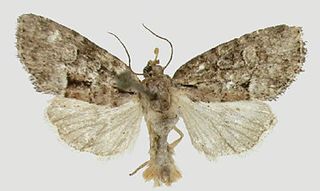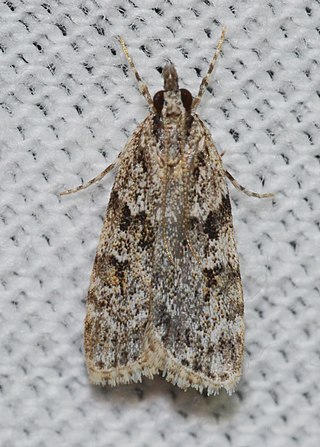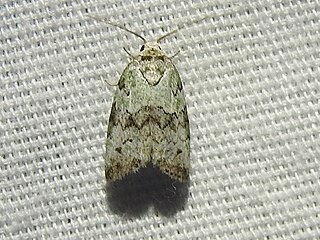Langessa is a genus of moths of the family Crambidae. It contains only one species, Langessa nomophilalis, the black langessa moth, which is found in North America, where it has been recorded from Alabama, Florida and South Carolina.

Phalonidia lavana, or Platphalonidia lavana, is a species of moth of the family Tortricidae, the subfamily Tortricinae, and the tribe Cochylini. It has a terrestrial habitat and is found throughout North America. It does not have a Global Conservation Status Rank.

Cherokeea attakullakulla is a moth in the family Noctuidae and the only species in the genus Cherokeea. It is found in North Carolina and Georgia.

Chrysendeton medicinalis, the bold medicine moth, is a moth in the family Crambidae. It was described by Augustus Radcliffe Grote in 1881. It is found on North America, where it has been recorded from Alabama, Florida, Georgia, Illinois, Indiana, Kentucky, Maryland, Mississippi, North Carolina, Ohio, Pennsylvania, South Carolina, Tennessee, Texas and West Virginia.
Dicymolomia opuntialis is a moth in the family Crambidae. It is found in North America, where it has been recorded from California.
Dichogama colotha is a moth in the family Crambidae. It is found in Costa Rica, Mexico and the United States, where it has been recorded from Texas. It is also found in Puerto Rico.
Donacaula nitidellus is a moth in the family Crambidae. It was described by Harrison Gray Dyar Jr. in 1917. It is found in North America, where it has been recorded from Alberta, Alabama, Connecticut, Georgia, Maryland, Massachusetts, Mississippi, New Jersey, New York, North Carolina, South Carolina and Texas.
Eudonia extincta is a moth in the family Crambidae. It was described by Harrison Gray Dyar Jr. in 1921. It is found in the Distrito Federal of Mexico.
Eudonia excursalis is a moth in the family Crambidae. It was described by Harrison Gray Dyar Jr. in 1929. It is found in Costa Rica.
Eudonia inexoptata is a moth in the family Crambidae. It was described by Harrison Gray Dyar Jr. in 1929. It is found in Mexico.

Eudonia leucophthalma is a moth in the family Crambidae. It was described by Harrison Gray Dyar Jr. in 1929. It is found in North America, where it has been recorded from British Columbia and Alberta to Washington and California.
Eudonia ycarda is a moth in the family Crambidae. It was described by Harrison Gray Dyar Jr. in 1929. It is found in Guatemala and Orizaba, Mexico.
Eudonia schwarzalis is a moth in the family Crambidae. It was described by Harrison Gray Dyar Jr. in 1906. It is found in North America, where it has been recorded from Arizona.

Scoparia biplagialis, the double-striped scoparia moth, is a moth in the family Crambidae. It was described by Francis Walker in 1866. It is found in North America, where it has been recorded from Alabama, Alaska, Alberta, British Columbia, California, Colorado, Florida, Georgia, Illinois, Indiana, Kentucky, Maine, Manitoba, Maryland, Massachusetts, Michigan, Minnesota, Montana, New Brunswick, New Hampshire, New Jersey, New York, North Carolina, North Dakota, Nova Scotia, Ohio, Ontario, Oregon, Pennsylvania, Quebec, Tennessee, Virginia, Washington, West Virginia and Wisconsin.
Scoparia normalis is a moth in the family Crambidae. It was described by Harrison Gray Dyar Jr. in 1904. It has been recorded from the US states of Arizona, Colorado, New Mexico, North Carolina and Utah.
Scoparia penumbralis, the dark-brown scoparia moth, is a moth in the family Crambidae. It was described by Harrison Gray Dyar Jr. in 1906. It is found in North America, where it has been recorded from Alabama, Maine, Maryland, Massachusetts, Michigan, Minnesota, Newfoundland, North Carolina, Nova Scotia, Ohio, Ontario, Quebec, South Carolina, Tennessee, West Virginia and Wisconsin.
Noctueliopsis pandoralis is a moth in the family Crambidae. It was described by William Barnes and James Halliday McDunnough in 1914. It is found in Mexico and the southern United States, where it has been recorded from New Mexico.
Boryzops purissima is a species of moth of the family Erebidae. It is found in the southern United States, where it has been recorded from Florida and Texas, as well as in Veracruz in Mexico, Costa Rica and Jamaica.
Gnorimoschema ericameriae is a moth in the family Gelechiidae. It was described by Keifer in 1933. It is found in North America, where it has been recorded from California.

Afrida ydatodes, or Dyar's lichen moth, is a species of moth in the family Nolidae. It was described by Harrison Gray Dyar Jr. in 1913 and is found in North America, where it has been recorded from Alabama, Florida, Mississippi, North Carolina and Texas.





